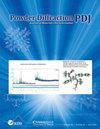泛影葡胺(C7H18NO5)(C11H8I3N2O4)的晶体结构
IF 0.4
4区 材料科学
Q4 MATERIALS SCIENCE, CHARACTERIZATION & TESTING
引用次数: 0
摘要
利用同步加速器X射线粉末衍射数据对泛影葡胺的晶体结构进行了求解和细化,并利用密度泛函理论技术对其进行了优化。泛影葡胺在空间群P21(#4)中结晶,a=10.74697(4),b=6.49364(2),c=18.552774(7)Å,β=90.2263(3),V=1292.985(5)Å3和Z=2。获得了两种不同的晶体结构,它们产生了基本上相同的精细残差和非H原子的位置。不同之处在于H原子的位置和氢键。一种结构的能量比另一种低123.0kJ/mol/cell,并被用于最终描述。晶体结构由沿着c轴交替的阳离子和阴离子双层组成。氢键将阳离子和阴离子连接成一个三维框架。阳离子铵态氮上的每个氢原子都作为强N–H·O氢键的供体。其中一个是另一个阳离子的羟基,另一个是阴离子的羧酸根。阴离子的每个酰胺氮原子都形成一个强大的N–H·O分子间氢键,一个与羰基相连,另一个与羧酸根相连。粉末图案已提交给ICDD,以纳入粉末衍射文件™ (PDF®)。本文章由计算机程序翻译,如有差异,请以英文原文为准。
Crystal structure of meglumine diatrizoate, (C7H18NO5)(C11H8I3N2O4)
The crystal structure of meglumine diatrizoate has been solved and refined using synchrotron X-ray powder diffraction data and optimized using density functional theory techniques. Meglumine diatrizoate crystallizes in space group P21 (#4) with a = 10.74697(4), b = 6.49364(2), c = 18.52774(7) Å, β = 90.2263(3), V = 1292.985(5) Å3, and Z = 2. Two different crystal structures, which yielded essentially identical refinement residuals and positions of the non-H atoms, were obtained. The differences were in the H atom positions and the hydrogen bonding. One structure was 123.0 kJ/mol/cell lower in energy than the other and was adopted for the final description. The crystal structure consists of alternating double layers of cations and anions along the c-axis. The hydrogen bonds link the cations and anions into a three-dimensional framework. Each of the hydrogen atoms on the ammonium nitrogen of the cation acts as a donor in a strong N–H⋯O hydrogen bond. One of these is to a hydroxyl group of another cation, and the other is to the carboxylate group of the anion. Each of the amide nitrogen atoms of the anion forms a strong N–H⋯O intermolecular hydrogen bond, one to a carbonyl and the other to a carboxylate group. The powder pattern has been submitted to ICDD for inclusion in the Powder Diffraction File™ (PDF®).
求助全文
通过发布文献求助,成功后即可免费获取论文全文。
去求助
来源期刊

Powder Diffraction
工程技术-材料科学:表征与测试
CiteScore
0.90
自引率
0.00%
发文量
50
审稿时长
>12 weeks
期刊介绍:
Powder Diffraction is a quarterly journal publishing articles, both experimental and theoretical, on the use of powder diffraction and related techniques for the characterization of crystalline materials. It is published by Cambridge University Press (CUP) for the International Centre for Diffraction Data (ICDD).
 求助内容:
求助内容: 应助结果提醒方式:
应助结果提醒方式:


